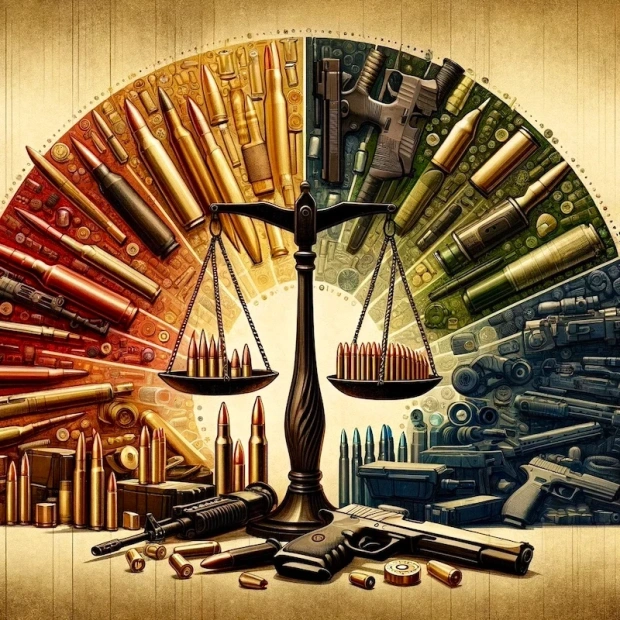Search
Cart
There are no items in your cart.
Login
In Defense of Caliber Diversity: A Closer Look at Ammunition Selection in Tactical Contexts

The ongoing shift in preference from larger calibers such as 10mm, .40 S&W, .45 ACP, and .357 Magnum to the more commonly used 9mm in law enforcement and military operations has ignited a heated debate. This transition, often justified by advancements in ballistic technology, has led some to argue that the modern 9mm rounds are as effective as their larger counterparts. However, this argument glosses over a critical aspect of ammunition selection: the context-specific nature of optimal caliber choice.
The Misconception of Universality
At the heart of the controversy is a tendency to oversimplify the decision-making process behind ammunition selection, treating it as a one-dimensional choice driven primarily by economic considerations or the quest for operational simplicity. This perspective not only undermines the complexity inherent in these decisions but also risks promoting a suboptimal standard of operational efficiency and effectiveness.
The Argument for Larger Calibers
Advancements in ballistic engineering have undoubtedly improved the performance of all calibers, including the 9mm. However, the same technological progress has also enhanced the capabilities of larger calibers, maintaining their superiority in terms of raw stopping power and terminal ballistics. Larger calibers retain their advantage in producing more significant wound channels, a factor that can be decisive in neutralizing threats more efficiently in certain scenarios. The argument here is not against the effectiveness of the 9mm but rather against the notion that advancements have leveled the playing field entirely.
Caliber Selection: Strategy Over Convenience
A critical flaw in the widespread adoption of the 9mm by default lies in scientifically-sounding sophistic arguments presented to justify its preference. These arguments, often masquerading as rational, overlook the potential for lowering standards of workforce quality and negatively impacting mission success. The allure of the 9mm, with its manageability, capacity, and broad accessibility, might inadvertently set a standard that is not universally optimal. True tactical flexibility demands the selection of the right tool for the job, based on a comprehensive assessment of operational needs rather than convenience or cost-efficiency.
This discussion advocates for a decision-making paradigm in which the choice of caliber is precisely aligned with the mission's specific demands. Such a paradigm requires operators to possess a versatile skill set, enabling them to adapt to a choice of caliber that is determined by the unique requirements of each mission. Selecting a 9mm—or any other caliber—should be a deliberate decision, guided not just by its general appropriateness but by a strategic assessment of the task at hand. This includes considering engagement distance, barrier penetration needs, and magazine capacity requirements. It’s important to underscore that a higher magazine capacity should not serve as compensation for an operator's lack of skills. Instead, it should be strategically chosen based on specific mission requirements, such as the need for sustained cover fire, rather than defaulting to higher capacity for the sake of it.
The Case for a Balanced Approach
The debate should not be framed as an either/or proposition between larger calibers and the 9mm but rather as an argument for a more nuanced approach to caliber selection. This approach acknowledges the strengths and weaknesses of each option, recognizing that there is no one-size-fits-all solution in the realm of tactical operations.
Operators must be proficient across various calibers, choosing them to match operational demands and tactical advantages. Their training and skill level should enable flexibility and adaptability, making versatility a cornerstone of their effectiveness. This ensures that every decision regarding ammunition selection is grounded in a deep tactical understanding and is aimed at maximizing operational effectiveness and safety. Training programs should aim not only to achieve proficiency across a spectrum of calibers but also to instill a deep understanding of the strategic considerations guiding these choices.
Toward a More Strategic Ammunition Selection
The trend towards adopting the 9mm as a standard, driven by its logistical and economic advantages, highlights the need for a nuanced approach to ammunition choice that goes beyond mere convenience or cost. Emphasizing the role of larger calibers for specific operational needs isn't a critique of progress nor an acceptance of lower standards; rather, it's an advocacy for a deeper tactical and strategic insight. The primary objective should be to empower law enforcement and military personnel with the discernment and versatility to select ammunition that best aligns with the unique demands of each mission. This approach ensures that decisions about caliber are made with a clear focus on maximizing effectiveness and operational success, recognizing the critical role that the right ammunition can play in achieving mission objectives.
NEWSLETTER










Leave a Comment